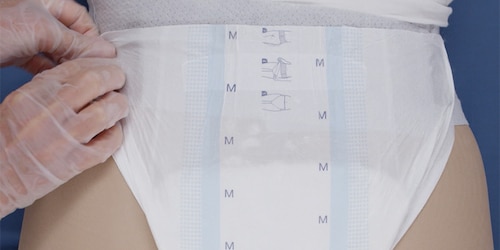It’s never a nice feeling to wear something with the wrong fit. This is especially true when it comes to personal care products like incontinence pads, slips or pants. Not only can it be annoying to discover that one’s product is too big or too small; wearing the wrong size may mean a risk of leakages on clothes, or chafing of the skin, which can lead to skin abrasion or odour issues, and affect the personal dignity of your residents.
Here are some tips for choosing the right incontinence product, and some basic info on the importance of product types, quality, size, and changing frequency.
Start with an assessment
To successfully manage your resident’s incontinence, you’ll need to make an accurate assessment and evaluation of his or her situation and needs, as well as a personalized care plan. Doing this will enable you to develop accurate care intervention strategies, and to determine the most suitable incontinence products for them to use. Such an assessment will also give the resident an indication of when and how often to change, and when to use the toilet.
Choosing the right type of product
Your choice of product should be based on your residents’ individual needs. Choosing the right type of product not only improves your residents’ quality of life, it could also ease your own workload.
- For residents who are immobile, belted products are easy for carers to handle and change, and are suitable for most body types.
- For residents who are mobile enough to use the toilet themselves, a pant-type product may be more suitable, since it helps them maintain independence and dignity.
Choosing the right size
Regardless of what kind of incontinence your resident is dealing with, correct measurement and sizing are essential for optimal care. By taking your resident’s waist and hip measurements, you can find out which product size is most likely to work for them. Learn more about measurement and sizing in our helpful article on how to choose the right size for incontinence products.
The right absorption capacity
The absorption capacity of the selected product should always be based on the amount of leakage, which may differ depending on the time of day, fluid intake, intake of diuretics, and pad changing frequency.
When determining the absorption capacity needed, also take into account your resident’s ability to access the toilet. Make sure everything possible is being done to help him or her reach the bathroom as needed. Incontinence products should not be used as a replacement for toileting.
You may find that TENA products with high absorption capacity is the best choice for some residents, and for other ones you may consider TENA products with a lower absorbency level. Keep in mind that products with a higher absorption capacity than necessary usually mean more cost and more waste.
The importance of quality
Aside from choosing the right size and absorbency level, it’s also important that the product:
- Is comfortable to wear
- Has soft material that’s gentle to the skin
- Keeps the skin dry and protects against leaks
- Is breathable, to promote skin health
- Prevents unwanted odours
Optimal fitting and changing frequency
When fitting an incontinence product, make sure it’s securely attached and snug in the groin. This is to avoid discomfort and chafing, and also to prevent leakage.
How often a product should be changed depends on your resident’s individual needs, which your assessment has identified. For example, a person with fragile skin or bowel incontinence needs to change more frequently, while a person with healthy skin and mobility issues may prefer less frequent changes.
Please see our Product Fitting Guides for further information and more examples on how to fit an incontinence product.
Establish a care plan
Each resident’s care plan should identify the right toileting program and the most suitable type of product, in the right size and with the correct absorption level. The changing routines should be adapted to that person’s specific needs. This may take time, but the result is worth it. A correctly fitted product, in combination with the right changing and toileting routines, will help improve your residents’ quality of life, by giving them:
- Protection against leakage
- Relief from odours
- Improved skin health
- Comfort
- Improved personal dignity
A correctly fitted product will also positively affect the workload for staff. Care procedures can be optimised, resulting in fewer product changes – and less waste.




